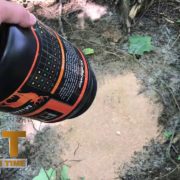Hinge-Cutting for Deer Habitat
Improve Your Deer Habitat with Hinge-Cutting
Quality time in the woods can mean a lot of different things to different people, but one thing is for sure, the condition of habitat can sure improve the value of the time you invest in what you love. Deer hunters understand the value of excellent habitat, the health of the deer herd, and the amount of time deer spend in a specific area. A small parcel of perfect habitat is worth more than acres and acres of poorer country that doesn’t hold deer. Working to improve the terrain you invest your hunting time in not only creates better hunting, but it forms a bond between the hunter and the land. Roots run deep when hunters contribute to their country and in turn the hunt.
Oftentimes, hunters can invest some weekend sweat equity into their hunting locations, and with a few simple techniques improve the deer habitat and the hunt. Don’t be afraid to get out into the woods early, before season, and get dirty. A little sweat and grease never hurt anyone, and with a few simple tools you can really do some good. Roll up your sleeves, put on your work boots, and pull on a pair of gloves to create some habitat improvements that will last for years to come. Tooled up with a simple limb saw, crosscut saw, or a chainsaw; you can spend a little time and make a big difference by hinge-cutting timber strategically.
What is Hinge-Cutting?
Hinge cutting is an easy to perform micromanagement habitat modification technique that is quick to achieve and cost effective. The technique involves cutting through an established tree part of the way until the tree lays over while still being partly attached to the root structure. Hinge cutting quickly creates a living horizontal habitat that deer love for browse and cover. Hinging timber has multiple effects, and multiple uses.
Bedding Areas
The horizontal cover created by hinge-cutting creates screening cover, adding security to bedding areas. Deer seek low covered secluded areas that offer hidden bedding areas for rest during daylight hours. Hinge-cutting provides the natural horizontal cover deer are looking for.
Canopy Management
Whitetail deer are natural browsers, seeking weeds, forbes, and legumes as their feed of choice. Heavily timbered areas on your hunting property create a thick canopy that blocks out the nourishment of the sun’s rays. By hinge-cutting openings in the canopy and allowing the sun onto the forest floor, you can create small grazing areas that deer will love. Another plus of canopy management is bringing down the succulent leaves of trees that deer like to feed on. When properly done, hinge cut tree tops will sprout new leaves for many seasons, offering terrific browse.

Travel Corridors and Funnels
Deer are often creatures of habit, traveling the same areas and even pathways time after time. Pre-rut and post-rut bucks can be patterned with some work and care to consider the wind. Hinge-cutting vertical timber into horizontal cover is a great strategy for creating pathways, directing deer travel, and establishing travel corridors in your hunting area.
Cutting Method
Consistently achieving successful hinge cuts takes a little practice and care in the cutting method. Cutting downward at a 45-degree angle produces the best results. Effective hinge cuts are generally made from knee to waist high. Cut ⅔ to ¾ of the way through the tree trunk, cutting just enough to free the top of the tree to fall or be pushed to the ground. Take care to plan your cuts, directing where the tree top will fall.
When and What to Cut
Flexible timber, and woods that don’t split well for firewood make an excellent choice for hinge-cutting. Soft species like elm and poplar are ideal candidates for hinge-cutting. Young saplings and smaller trees with a lot of new growth are the right size for hinge-cutting. Hinge-cutting is a practice that is best to do when the weather is warm and tree fluid is in an active state. Cold temperatures can cause trees to become hard and brittle with a greater chance of breaking and killing the top of the tree.
Putting it All Together
Put in the Work
Hunters who aren’t afraid to get their hands dirty and put in a little work can reap the benefits of habitat improvement, and hinge-cutting timber blocks is a great start. By selecting the right species and size of timber during warm weather you can effectively influence multiple aspects of your hunting property. Hinge-cutting, when done correctly is a great investment of time and resources with a huge payback.
Don’t Fail to Plan
Hinge-cutting is a simple strategy that can positively affect your deer habitat in many ways. Don’t rush in, chopping random trees, but instead take into consideration: bedding habitat, tree canopy, travel corridors, tree species and size when you’re planning your hinge-cutting.
Keep the Hunt in Mind
Don’t let the warm weather and power tools go to your head. It’s important to keep the plan and goal in mind. The end game here is deer hunting, and putting in some work to make this season, and seasons to come more successful. Be ever mindful of your hunting strategy and how it will change throughout the season. Keep in mind details like wind direction, stand placement, food plots, travel ways, and how you plan to get into and out of the hunting area.
It won’t be long until the days grow short and whitetail bucks are in the rut. Hunters all across the nation will be dreaming of time in the woods, taking vacation days, and longing for cold fronts. Some forethought, planning, and muscle in late summer and early fall will go a long way to putting your tag on a deer this season. Whether you are a trophy hunter hoping for a chance at a heavy racked bruiser, a hunter hoping to put meat on the table for your family, or somewhere in between; you can be sure that improving your deer habitat with hinge-cutting will better your chances either way.







Leave a Reply
Want to join the discussion?Feel free to contribute!